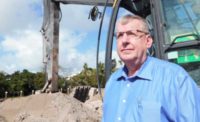

In kicking off an international design competition to attract ideas for saving vulnerable areas from the rising tides, Boston Mayor Martin J. Walsh (D) nailed home the importance of taking a regional approach to climate-change preparations by also announcing a multi-city living-with-water summit, set for next spring.
"When Hurricane Sandy hit, we weren't any more prepared than New York or New Jersey—just luckier," said Walsh at an Oct. 29 event, held in conjunction with the Boston Society of Architects' ArchitectureBoston Expo 2014. Climate-change preparation "has to be a truly regional effort," said Walsh.
If Sandy's storm surge had peaked at high tide, Boston would have experienced a 100-year flood (ENR 10/13 p. 10). Sea level in the city, which sits just above the high-tide level, has risen one foot over the past century. Climate scientists predict a 2-ft to 6-ft rise by 2100.
The half-day metropolitan-Boston summit hopes to create a mechanism to coordinate regional, cross-government action. Participants include MassPort, MassDOT and the Massachusetts Water Resources Authority as well as mayors from the Metropolitan Area Planning Council's Metro Mayor's Coalition. The coalition includes Boston, Cambridge, Chelsea, Everett, Malden, Melrose, Medford, Quincy, Revere, Somerville, Brookline, Winthrop and Braintree. A date for the meeting, organized under the Greenovate Boston campaign and to take place at the University of Massachusetts, Boston, has not been announced.
This month, the city plans to release the latest draft of its Climate Action Plan for public comment. The multi-agency plan, updated every three years, serves as Boston's blueprint for reaching its goals of reducing greenhouse-gas emissions 25% by 2020 and 80% by 2050. It is also a document that helps to ensure the city is prepared for the impacts of climate change, including dealing with the rising tide.
Beyond the physical environment, the plan focuses on community engagement, social equity and green jobs. Information about activities aimed at reducing the city's carbon footprint can be found at www.greenovateboston.org.
Design Competition
The design competition, called "Boston Living With Water," invites multidisciplinary teams to submit solutions to deal with sea-level rise for three sites: a building, a neighborhood and transportation infrastructure. The sites were chosen for their vulnerability to flooding.
The hope is that the winning solutions will influence development activities, says the Boston Society of Architects, which is holding the competition with the city, the Boston Harbor Association (BHA) and the Boston Redevelopment Authority. "Competition solutions should address the unique aspects of the selected site, while being replicable elsewhere," says BSA in the call for entries.
The sites are the Prince Building in the North End, which typifies Boston's historic waterfront fabric; a 100-acre section of Fort Point Channel, which represents a large, urban, mixed-used redevelopment opportunity, typical of other city districts; and Morrissey Boulevard, near the outer harbor and mouth of the Neponset River, which provides access to the Columbia Point peninsula and a range of residential, commercial, institutional and open-space areas. The street, which already floods, "exemplifies the critical transportation infrastructure connecting Boston's neighborhoods," says BSA.
Competition entries are due on Jan. 29. Finalists will be announced late in February and winners on May 29. The first place prize is $20,000.
The competition is funded by an $86,000 grant from the Massachusetts Office of Coastal Zone Management and a $35,000 grant from the Barr Foundation. Details can be found at www.boston livingwithwater.org.
Thanks to sea-level rise, Boston's coastline is expected to revert, by 2375, to its 1775 coastline—before its marshlands were filled. BHA Executive Director Julie Wormser asked, "What do we do between today and 2375 to maintain a vibrant city as we deal with more and more water?"



Post a comment to this article
Report Abusive Comment